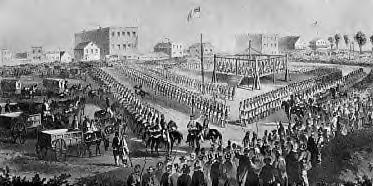|
Canku Ota |
|
(Many Paths) |
|
An Online Newsletter Celebrating Native America |
|
December 16, 2000 - Issue 25 |
|
|
|
Uprising - The Cost of Arrogance |
|
by Ondamitag |
|
The execution of the Dakota 38 If we ever wonder what the cost for being arrogant can be, all we need to do is look into the Santee Sioux Uprising of 1862. |
|
||
| On December 26, 1862, the day after Christmas, in Mankato, Minnesota, the largest mass execution, in this country, occurred. It was the day that 38 Dakota were executed. At 10 a.m., the condemned, singing and chanting Dakota songs, were led to the scaffolds, in Mankato. Three drumbeats signaled the moment of execution, the crowd cheered. Bodies were buried in a single grave on the edge of town. | |||
| How did this all start? What caused these people to go on the warpath? | |||
| In August, of 1862, annuity payments were late and rumors circulated that payments, if they were made at all, it would not be in the customary gold because of the ongoing Civil War. The Dakota planned to demand that future annuity payments be made directly to them, rather than through traders. Traders, learned of plan, and refused to sell provisions on credit, despite widespread hunger and starvation, on the reservation. At a meeting called, by Indian Agent Thomas Galbraith, to resolve the impasse, Andrew Myrick, spokesman for the traders, says: "So far as I am concerned, if they are hungry, let them eat grass." | |||
| These were the words that started the grassfire of the uprising. On August 17, 1862, four young Dakota killed five settlers near Litchfield. Councils were held, among the Dakota, on whether to wage war. Despite deep divisions on the issue, war was the chosen course. Then on August 18, 1862, groups of Dakota killed 44 Americans, in attacks on the Redwood Agency and on federal troops advancing, towards the Agency, in the hopes of suppressing the uprising. Ten Americans were captured. On August 19, 1862 Sixteen settlers were killed in Dakota attacks, in and around New Ulm. Settlers crowded into a small barricaded area, of New Ulm's main street. | |||
| The Dakota attacked Fort Ridgely on August 20 & 21, 1862. The Fort was successfully defended. On August 23, 1862, about 650 Dakota attacked New Ulm, for a second time. Most buildings in the town were burned. Although 34 died and 60 were wounded, the town was successfully defended. On September 2, 1862, in the Battle of Birch Coulee (near Morton), American troops suffered their greatest casualties of the war. | |||
| On September 23, 1862, the battle of Wood Lake was the decisive victory for American troops. While the Wood Lake fighting was in progress, Dakota opposed, to continuation, of the war, took control of 269 American captives held near the Chippewa River. On September 26, 1862, "Friendlies" released American captives. Col. Sibley entered the Dakota camp and took 1200 Dakota men, women, and children into custody. Over the next weeks, an additional 800 Dakota would surrender, to American forces. In 37 days of fighting, the Dakota Conflict had claimed the lives of over 500 Americans and about 60 Dakota. | |||
| The uprising ended and the revenge began. On September 28, 1862 Sibley appointed a five-member military commission to "try summarily" Dakota for "murder and other outrages" committed against Americans. Sixteen trials took place, that same day. Ten Dakota were convicted and were sentenced to be hanged, six were acquitted. Over the next six weeks, 393 Dakota were tried. On November 3, 1862 the last of 393 trials were conducted, with 42 trials taking place, on the last day. In all, 323 Dakota were convicted and 303 were sentenced to be hanged. | |||
| Then on December 3, 1862, President Lincoln issued an order allowing only 39 of the planned 303 executions to go forward. The execution of one additional condemned man was suspended later, after new evidence cast doubt upon his guilt. | |||
| On December 24, 1862 the condemned were allowed to meet with their families for the last time. | |||
| On December 26, the United States executed 38 human beings for what they did out of hunger and humility. | |||
| The greed and arrogance of the Traders and the Indian Agents in that time and place are legendary. The lack of compassion shown by them, and many of the settlers, of the time, goes only to show that their standards were 'Justice for Just Us.' | |||
| I hope every one of us can learn that a little compassion can avoid an avalanche of hatred. | |||
|
There are a number of Historical Locations related to The Uprising in Minnesota:
|
|||
|
There is an excellent website with much more information, I highly recommend
it: |
|||
|
|
|
|
| Canku Ota is a free Newsletter celebrating Native America, its traditions and accomplishments . We do not provide subscriber or visitor names to anyone. Some articles presented in Canku Ota may contain copyright material. We have received appropriate permissions for republishing any articles. Material appearing here is distributed without profit or monetary gain to those who have expressed an interest. This is in accordance with Title 17 U.S.C. section 107. |
|
Canku Ota is a copyright of Vicki Lockard and Paul Barry. |
|
The "Canku Ota - A Newsletter Celebrating Native America"
web site and its design is the Copyright © 1999 of Paul C. Barry. |
